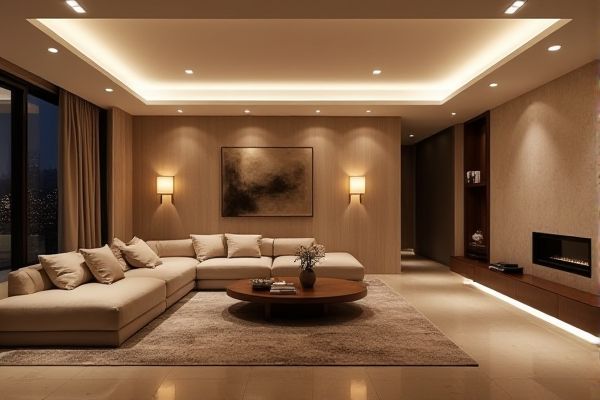
Recessed lighting provides a sleek, modern look by being embedded into ceilings, offering focused illumination without taking up space, while wall sconces add decorative charm and ambient lighting directly on walls, enhancing room aesthetics. Explore the rest of the article to discover which option best suits your lighting needs and style preferences.
Table of Comparison
| Feature | Recessed Lighting | Wall Sconces |
|---|---|---|
| Installation | Installed flush into ceiling or walls; requires professional wiring | Mounted on walls; easier to install than recessed lighting but may need wiring |
| Space Usage | Space-saving, minimal visual impact | Occupies wall space, can serve as decorative element |
| Lighting Type | Ambient or task lighting with wide coverage | Accent or ambient lighting with directional focus |
| Style Options | Modern, sleek, minimalistic designs | Varied styles from classic to contemporary |
| Maintenance | More difficult to access for bulb replacement | Easy to access and maintain |
| Cost | Higher upfront installation cost | Generally lower installation cost |
| Energy Efficiency | Compatible with energy-efficient LED bulbs | Also compatible with LED and energy-saving bulbs |
| Best Use | General lighting, kitchens, bathrooms, hallways | Accent walls, mood lighting, entryways, living rooms |
Introduction to Recessed Lighting and Wall Sconces
Recessed lighting offers a sleek, unobtrusive design that integrates seamlessly into ceilings, providing focused and ambient illumination ideal for modern interiors. Wall sconces add decorative flair and accent lighting by mounting directly on walls, enhancing your room's ambiance with both functional and artistic appeal. Choosing between recessed lighting and wall sconces depends on your desired lighting effect, spatial constraints, and style preferences.
Design Aesthetics: Modern vs Classic Appeal
Recessed lighting offers a sleek, minimalist design that enhances modern interiors by providing unobtrusive illumination and clean ceiling lines. Wall sconces bring a classic, decorative element with various styles ranging from ornate to traditional, adding character and warmth to a space. Choosing between recessed lighting and wall sconces depends on whether the goal is a contemporary, streamlined look or a timeless, elegant ambiance.
Space Considerations and Room Suitability
Recessed lighting optimizes space by being installed flush with the ceiling, making it ideal for rooms with low ceilings or limited wall space. Wall sconces add decorative appeal while providing focused ambient lighting, suitable for hallways, living rooms, or bedrooms with available wall space. Your choice depends on the room's dimensions and how much wall or ceiling area you can dedicate to lighting fixtures.
Light Distribution and Ambience
Recessed lighting offers a clean, unobtrusive source of illumination that provides even light distribution across a room, making it ideal for general lighting and highlighting architectural features. Wall sconces create a more directional, ambient glow that adds warmth and character to your space by casting light both upward and downward, enhancing mood and texture on walls. Your choice between these fixtures depends on whether you want broad, seamless lighting or focused, decorative accents to shape the room's ambience.
Installation Requirements and Differences
Recessed lighting requires cutting holes into the ceiling and often involves running electrical wiring above the ceiling, making it ideal for spaces with accessible attic or crawl spaces. Wall sconces are mounted directly on walls, necessitating electrical wiring within the wall or surface-mounted conduit, which can be simpler in rooms without ceiling access. Your choice depends on structural feasibility and the desired lighting effect, with recessed lights offering a sleek, unobtrusive appearance and sconces providing decorative accents.
Energy Efficiency and Light Output
Recessed lighting typically offers higher energy efficiency due to LED technology integration, providing focused and uniform illumination that reduces power consumption. Wall sconces, while aesthetically versatile, often use incandescent or halogen bulbs that consume more energy and produce softer, ambient light with lower lumen output. Selecting recessed lighting can enhance energy savings and improve task lighting effectiveness in modern interiors.
Cost Comparison: Upfront and Long-Term
Recessed lighting typically has higher upfront costs due to installation complexity and electrical work but offers long-term savings through energy-efficient LED options and minimal maintenance. Wall sconces generally involve lower initial expenses and easier installation, yet may incur higher long-term costs from bulb replacements and potential wall repairs. Evaluating energy consumption and durability is crucial when comparing these lighting solutions for budget-conscious projects.
Maintenance and Bulb Replacement
Recessed lighting requires less frequent bulb replacement due to its use of long-lasting LED bulbs, reducing maintenance efforts in ceilings or hard-to-reach areas. Wall sconces, meanwhile, offer easier access for bulb changes and cleaning, making maintenance simpler for fixtures mounted at eye level. Choosing between the two depends on your preference for convenience versus durability in lighting upkeep.
Customization and Control Options
Recessed lighting offers advanced customization with dimmable LED options and smart home integration, allowing precise control over brightness and ambiance. Wall sconces provide versatile placement and style choices, and many models now support adjustable brightness and color temperature, enhancing personalized lighting scenes. Both lighting options can be paired with programmable switches or apps for tailored lighting control, catering to various design and functional preferences.
Best Applications: Choosing the Right Fixture
Recessed lighting is ideal for providing unobtrusive, ambient illumination in rooms with low ceilings or minimal wall space, enhancing overall brightness without visual clutter. Wall sconces excel in creating focused accent lighting, adding decorative elements, and illuminating pathways or corners, making them perfect for hallways, living rooms, and bedrooms. Selecting the right fixture depends on spatial requirements, design goals, and whether you need diffuse general lighting or targeted illumination.
 homyna.com
homyna.com